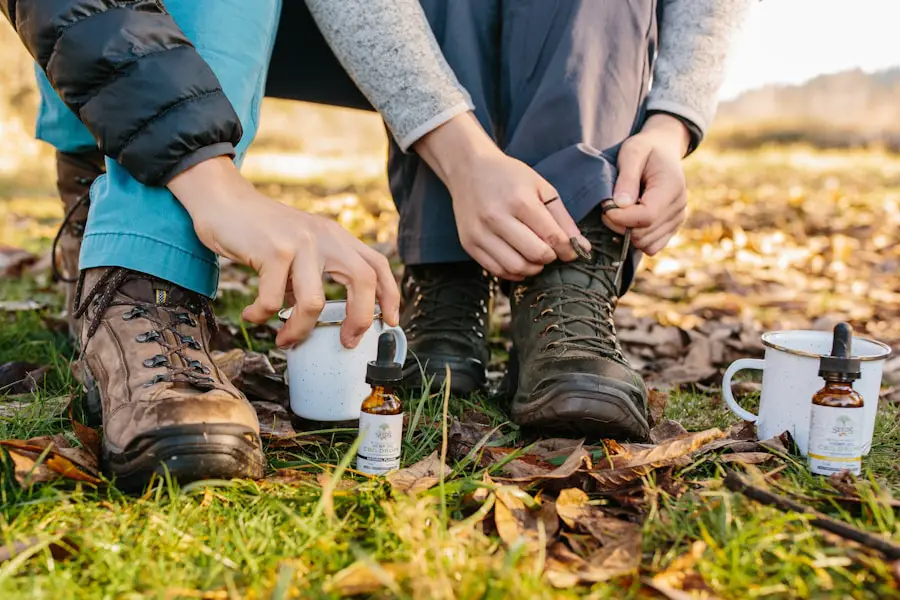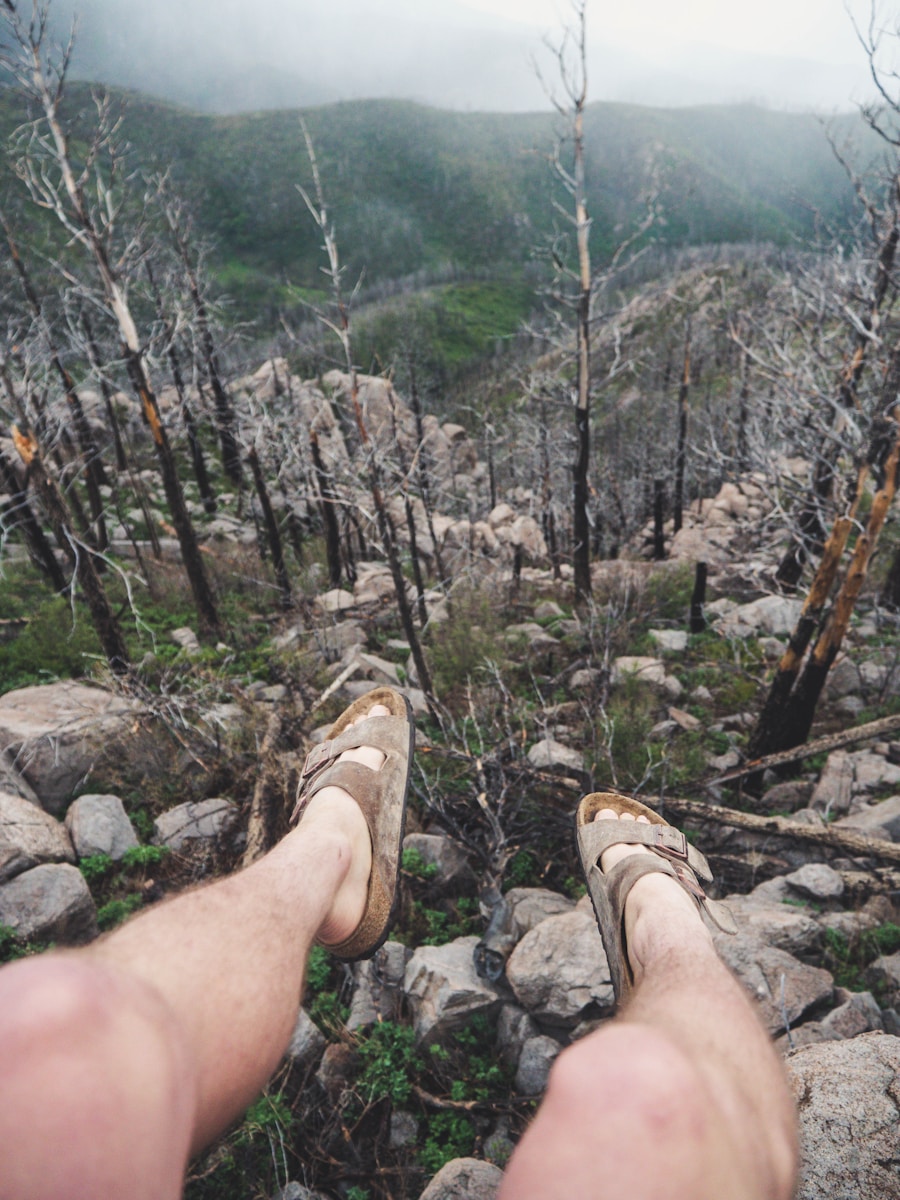Blisters are small pockets of fluid that form between the layers of skin, often as a result of friction, heat, or moisture. When hiking, the repetitive motion of walking can create friction between the skin and footwear, leading to irritation and, ultimately, blister formation. This is particularly common in areas where the skin is more susceptible to rubbing, such as the heels, toes, and the balls of the feet.
The body’s natural response to this irritation is to create a protective bubble of fluid, which serves to cushion the damaged skin underneath. However, while blisters may serve a protective function, they can also be painful and debilitating, making it essential for hikers to understand their causes to prevent them effectively. In addition to friction, other factors contribute to blister formation.
Heat plays a significant role; as the skin warms up during physical activity, it becomes more pliable and susceptible to damage. Moisture from sweat or wet conditions can exacerbate this issue by softening the skin and increasing friction. Furthermore, poorly fitting footwear can lead to excessive movement of the foot within the shoe, heightening the risk of blisters.
Understanding these causes is crucial for hikers who wish to enjoy their outdoor adventures without the discomfort that blisters can bring.
Key Takeaways
- Friction and moisture are the main causes of blisters during hiking.
- Choose hiking footwear that fits well and provides good support to prevent blisters.
- Wearing moisture-wicking socks and liners can help prevent blisters by reducing friction.
- Prepare your feet for the trail by keeping them clean, trimming nails, and using foot powder.
- Use blister-prevention products such as moleskin, tape, or blister pads to protect vulnerable areas on your feet.
Choosing the Right Footwear for Hiking
Selecting appropriate footwear is one of the most critical steps in preventing blisters while hiking. The right pair of hiking boots or shoes should provide a balance between support, comfort, and protection. When choosing hiking footwear, it is essential to consider the terrain you will be traversing.
For instance, rugged trails may require boots with more ankle support and a stiffer sole to protect against rocks and uneven surfaces. Conversely, lighter trails may allow for more flexible shoes that offer breathability and comfort without sacrificing support. Fit is paramount when it comes to hiking footwear.
A well-fitted shoe should allow for some wiggle room in the toes while ensuring that the heel is snug enough to prevent slipping. Many hikers make the mistake of purchasing shoes that are too tight in an attempt to avoid blisters; however, this can lead to increased pressure and friction. It is advisable to try on shoes at the end of the day when your feet are slightly swollen from daily activities, as this will give you a more accurate sense of how they will feel during a hike.
Additionally, wearing the same socks you plan to use on your hike while trying on shoes can help ensure a proper fit.
Socks and Liners: The Unsung Heroes in Blister Prevention

While footwear is crucial in preventing blisters, socks often play an equally important role that is frequently overlooked. The right socks can significantly reduce friction and wick moisture away from the skin, both of which are essential in blister prevention. Hikers should opt for socks made from synthetic materials or merino wool, as these fabrics provide better moisture management compared to cotton.
Cotton retains moisture and can lead to increased friction against the skin, making it a poor choice for hiking. In addition to choosing the right material, hikers should also consider using sock liners. Sock liners are thin socks worn underneath regular hiking socks and serve as an additional barrier between the foot and the outer sock.
This layering technique can help reduce friction by allowing the two layers of fabric to slide against each other rather than against the skin. Many hikers find that using liners not only helps prevent blisters but also enhances overall comfort during long treks.
Preparing Your Feet for the Trail
| Preparation Tips | Details |
|---|---|
| Choose the right footwear | Proper hiking boots or shoes with good ankle support |
| Trim your toenails | Keep them short to prevent discomfort and potential injury |
| Moisturize your feet | Prevent dryness and cracking by applying lotion regularly |
| Wear moisture-wicking socks | Help prevent blisters and keep your feet dry |
| Stretch and warm up | Prepare your feet and ankles for the trail ahead |
Preparation is key when it comes to ensuring your feet are ready for a hike. Before hitting the trail, it is essential to take some time to assess your feet and address any potential issues that could lead to blisters. This includes trimming toenails to prevent them from rubbing against the inside of your shoes and checking for any calluses or rough patches that may be prone to irritation.
Applying a moisturizing lotion can help keep the skin supple and reduce friction. Another important aspect of foot preparation is acclimatization. If you are planning a long hike or one that involves significant elevation changes, it is wise to gradually increase your hiking distance in the weeks leading up to your trip.
This allows your feet to adapt to the demands of hiking and helps build up calluses in areas that may be prone to blistering. Additionally, wearing your new hiking shoes on shorter walks before embarking on a longer trek can help break them in and ensure they fit comfortably.
Using Blister-Prevention Products and Techniques
In addition to proper footwear and sock choices, various blister-prevention products can enhance your defense against this common hiking ailment. One popular option is blister prevention tape or adhesive pads designed specifically for high-friction areas on the foot. These products create a protective barrier that reduces friction and helps prevent blisters from forming in vulnerable spots such as heels or toes.
Another effective technique involves applying blister prevention ointments or creams directly onto areas prone to friction before heading out on a hike. These products often contain ingredients that create a slippery surface on the skin, reducing friction and allowing for smoother movement within footwear. Some hikers also swear by using petroleum jelly on their feet as a simple yet effective method for preventing blisters.
Proper Foot Care During Hikes

Identifying Early Warning Signs
Regularly checking your feet throughout your hike can help you catch any signs of irritation before they develop into full-blown blisters. If you notice any hotspots—areas where you feel increased friction or discomfort—it’s crucial to address them immediately by adjusting your footwear or applying blister prevention products.
Staying Hydrated to Prevent Foot Problems
Staying hydrated is another essential aspect of foot care while hiking. Dehydration can lead to swelling in the feet, which may increase friction within your shoes and heighten the risk of blisters.
Taking Breaks to Rest and Assess
Make sure to drink plenty of water throughout your hike and take breaks when needed to rest your feet and assess their condition.
Dealing with Hotspots and Early Signs of Blisters
Recognizing hotspots early can be a game-changer in preventing blisters from forming during a hike. A hotspot typically presents itself as an area of discomfort or irritation on the foot, often accompanied by redness or warmth. As soon as you notice these signs, it’s essential to take action before they escalate into blisters.
One effective strategy is to stop and remove your shoes and socks for a few minutes to allow your feet to breathe and cool down. If you have blister prevention tape or adhesive pads on hand, applying them directly over the hotspot can provide immediate relief and protection against further friction. Additionally, adjusting your footwear—such as loosening laces or repositioning insoles—can help alleviate pressure on affected areas.
In some cases, simply changing your socks can make a significant difference in comfort levels.
Post-Hike Foot Care and Blister Treatment
After completing a hike, proper foot care is essential for recovery and preventing future issues. Begin by thoroughly cleaning your feet with soap and water to remove dirt and sweat accumulated during your trek. Drying your feet completely is crucial, especially between the toes, as moisture can lead to fungal infections if left unchecked.
If you have developed blisters during your hike, it’s important to treat them properly to avoid complications such as infection. If a blister has formed but remains intact, it’s generally best to leave it alone; this allows it to heal naturally while providing protection for the underlying skin. However, if a blister has burst or is particularly painful, clean the area gently with antiseptic and cover it with a sterile bandage or blister pad.
In addition to treating any blisters, consider implementing a post-hike foot care routine that includes moisturizing your feet with lotion or cream to promote healing and prevent dryness or cracking. Regular foot massages can also help improve circulation and alleviate tension built up during long hikes. By taking these steps after each hike, you can ensure that your feet remain healthy and ready for future adventures in the great outdoors.
If you’re planning a hiking trip and want to avoid blisters, one helpful article to check out is this guide on the best golf travel bags. While it may seem unrelated, the tips and tricks for protecting your feet while golfing can also be applied to hiking. Proper footwear and blister prevention techniques are key to a comfortable and enjoyable outdoor adventure.
Love travel? Join Our Facebook Community For More Tips.
FAQs
What causes blisters when hiking?
Blisters when hiking are typically caused by friction between the skin and the hiking boots or socks. This friction can result from ill-fitting footwear, moisture, or repetitive rubbing.
How can I prevent blisters when hiking?
To prevent blisters when hiking, it’s important to wear properly fitting hiking boots and moisture-wicking socks. Additionally, using blister prevention products such as moleskin, blister pads, or lubricants can help reduce friction and prevent blisters from forming.
What are some tips for preventing blisters on a hike?
Some tips for preventing blisters on a hike include breaking in new hiking boots before a long hike, keeping feet clean and dry, wearing moisture-wicking socks, and using hiking-specific blister prevention products.
How should I treat blisters if they do occur during a hike?
If blisters occur during a hike, it’s important to clean the area with mild soap and water, then cover the blister with a bandage or blister pad. It’s best to avoid popping the blister, as this can increase the risk of infection.
Are there any specific techniques for lacing hiking boots to prevent blisters?
Some hikers find that using specific lacing techniques, such as the heel lock or window lacing, can help reduce friction and prevent blisters on the feet. It’s important to experiment with different lacing techniques to find what works best for your feet.
